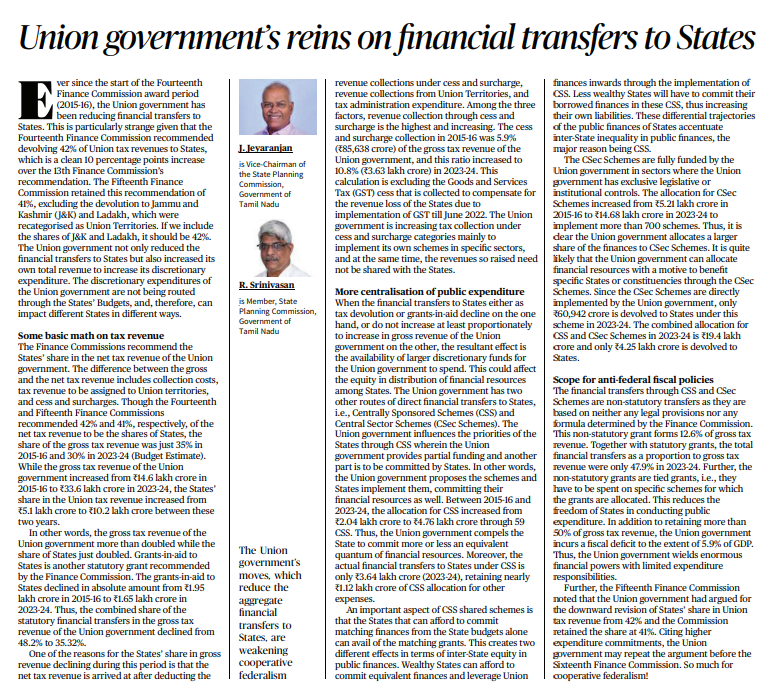Introduction
The period since the Fourteenth Finance Commission award (2015-16) has seen a reduction in financial transfers to states by the Union government, despite recommendations to increase devolution.
Decrease in Financial Transfers
- The Fourteenth and Fifteenth Finance Commissions recommended 42% and 41% respectively of the net tax revenue to be shared with states.
- However, the share of states in gross tax revenue declined significantly from 35% in 2015-16 to 30% in 2023-24.
- Grants-in-aid to states also decreased from ₹95 lakh crore to ₹1.65 lakh crore during this period.
- Factors contributing to this decline include increased revenue collection through cess and surcharge, which is not shared with states.
Centralization of Public Expenditure
- Reduction in financial transfers to states leads to larger discretionary funds for the Union government.
- Centrally Sponsored Schemes (CSS) and Central Sector Schemes (CSec Schemes) are avenues for direct financial transfers to states.
- CSS allocations increased significantly, but the actual transfers to states remained lower, with the Union government retaining a substantial amount for other expenses.
- CSS creates disparities among states, with wealthy states leveraging Union finances while less wealthy states increase their liabilities.
- CSec Schemes, fully funded by the Union government, also increased substantially, potentially benefiting specific states or constituencies.
- The combined allocation for CSS and CSec Schemes in 2023-24 was ₹4 lakh crore, with only ₹4.25 lakh crore devolved to states.
Scope for Anti-Federal Fiscal Policies
- Non-statutory transfers through CSS and CSec Schemes constitute a significant portion of gross tax revenue.
- These tied grants limit states’ freedom in public expenditure.
- The Union government retains more than 50% of gross tax revenue and incurs a fiscal deficit, giving it considerable financial power with limited expenditure responsibilities.
- The Union government’s argument for downward revision of states’ share in Union tax revenue undermines cooperative federalism.
Conclusion
The reduction in financial transfers to states and the increase in discretionary funds for the Union government raise concerns about equity in distribution of financial resources among states and cooperative federalism.
Introduction:
- The construction of the Ram temple in Ayodhya has generated widespread excitement and enthusiasm in the nation, rooted in a 500-year aspiration.
- The temple holds immense significance beyond just a religious structure, as it embodies the spirit of Lord Ram, deeply ingrained in the Indian ethos.
Historical and Cultural Context:
- The temple’s history is intricate, stretching back centuries, yet often misunderstood by those solely relying on news channels for information.
- Ram and the Ramayana hold a pivotal place in Indian culture, symbolizing righteousness, truthfulness, and compassion.
- The resonance of Ramayana with the Indian spirit signifies a revival of national ethos and values.
Inspiration from Ram’s Life:
- Ram’s enduring legacy stems from his ability to navigate through adversities with resilience and grace.
- Despite facing numerous trials, including loss of kingdom and separation from loved ones, Ram exemplified composure and adherence to duty.
- His post-war remorse underscores his commitment to righteousness and compassion, even towards adversaries.
The Concept of Maryada Purushottam:
- Ram is revered not merely as a deity but as a paragon of virtuous human qualities, embodied in the term “Maryada Purushottam.”
- His exemplary conduct commands universal respect, inspiring individuals to aspire towards moral excellence.
- The term reflects the ideal of human transcendence, emphasizing the potential for individuals to attain divine attributes through ethical living.
Civilisational Reclamation and Spiritual Evolution:
- The construction of the Ram temple represents a civilisational reclamation, transcending simplistic belief systems towards individual spiritual evolution.
- It signifies a shift from reliance on external gods towards self-realization and liberation.
- The temple serves as an iconic representation, inspiring individuals to pursue spiritual growth and transcendence.
Conclusion:
The Ram temple in Ayodhya symbolizes more than just a religious edifice; it embodies the enduring legacy of Lord Ram and the timeless values he represents.
Its construction marks a pivotal moment in India’s cultural and spiritual narrative, reflecting a collective aspiration towards moral excellence and spiritual evolution.
Introduction
The interim Union budget presented on February 1 serves as a pivotal point to gauge the government’s macroeconomic policy objectives amidst impending general elections.
Despite its interim nature, it sheds light on fiscal conservatism and policy priorities amid the current economic challenges.
Fiscal Outlook
- Nominal Figures: Total expenditure is budgeted at Rs 47.8 lakh crore, marking a modest 6.1% increase over revised estimates for 2023-24.
- Composition Shift: Notably, capital expenditure rises by 16.9%, reflecting a continued emphasis on infrastructure investment.
- Fiscal Conservatism: Real expenditure remains stagnant, signaling a conservative stance. Moreover, the focus on reducing the debt-to-GDP ratio to 40% underscores fiscal prudence.
Policy Objectives
- Debt-to-GDP Reduction: Government efforts to curb borrowing and primary deficit ratio align with the goal of reducing debt burden.
- Mitigating Expenditure Impact on GDP: Shifting expenditure towards capital investment aims to bolster economic growth amid spending constraints.
Critical Evaluation
- Debt-to-GDP Target: The fixation on a specific debt-to-GDP ratio raises questions regarding its necessity and effectiveness in addressing India’s developmental challenges.
- Employment Dynamics: Structural shifts in employment, particularly the rise in self-employment and stagnant wage growth, underscore the need for comprehensive policy interventions beyond fiscal conservatism.
- Income Distribution: The widening gap between GDP growth and labor earnings emphasizes the urgency for inclusive policies to address income disparities.
Conclusion
The interim budget reflects a mix of fiscal prudence and targeted expenditure aimed at sustaining economic growth.
However, it also highlights the imperative for a more holistic approach to address structural challenges, particularly concerning employment and income distribution, warranting deeper scrutiny and innovative policy responses beyond conventional fiscal frameworks.




